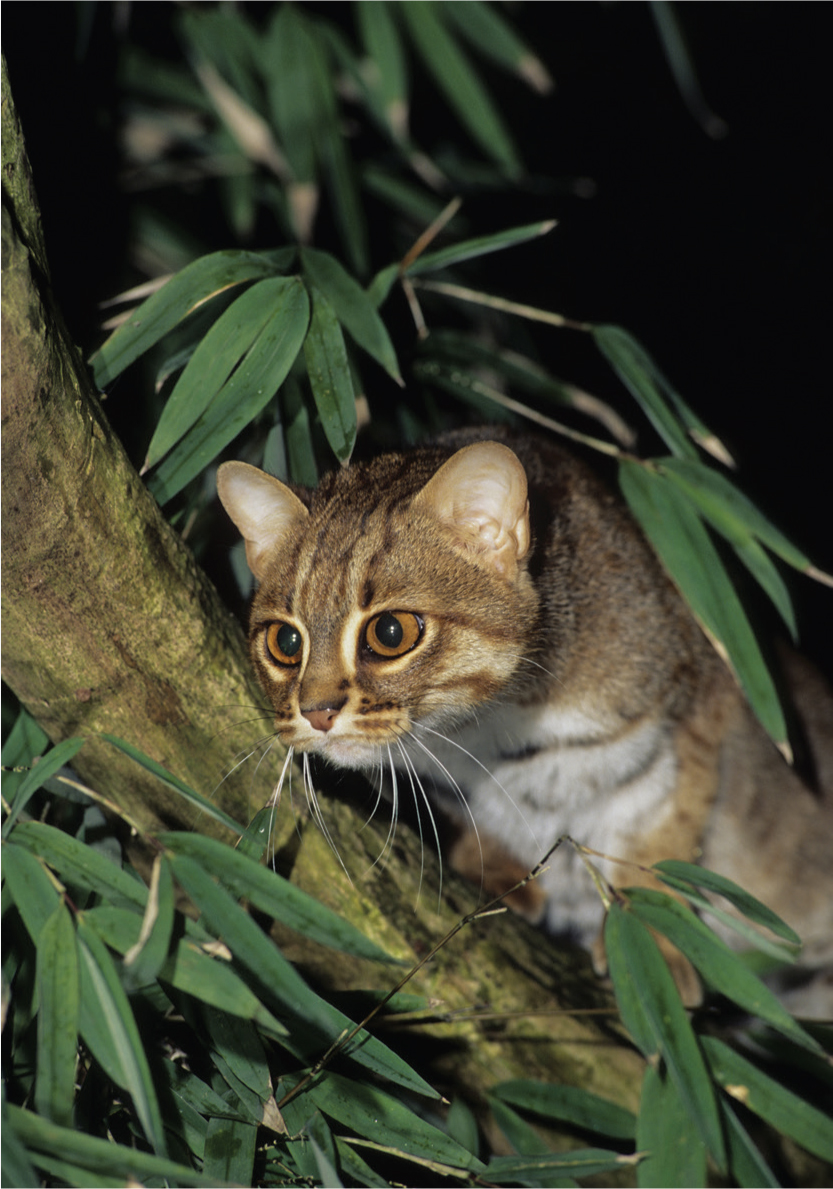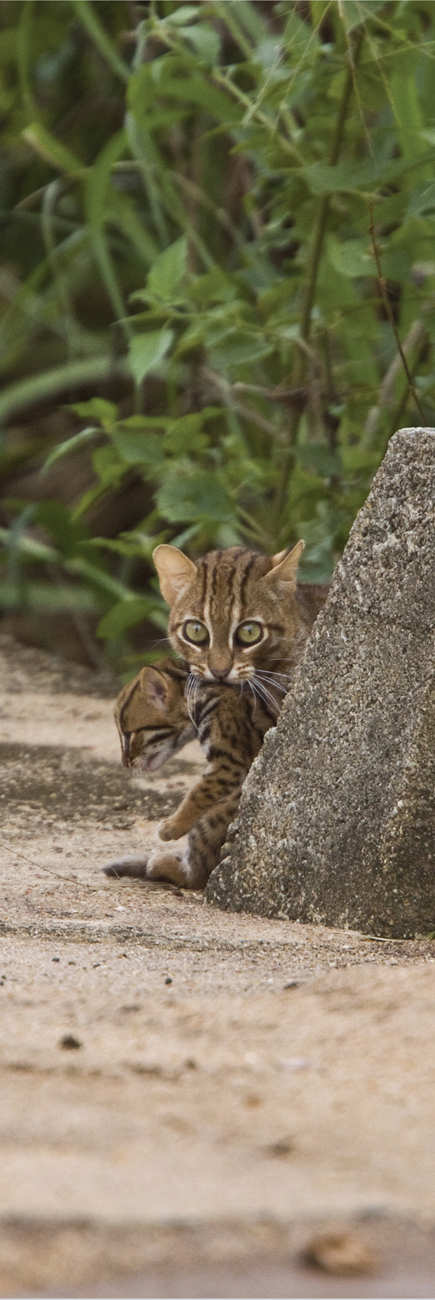
Rusty-spotted Cat
Prionailurus rubiginosus
(I. Geoffroy Saint-Hilaire, 1831)


 IUCN RED LIST (2008): Vulnerable
IUCN RED LIST (2008): Vulnerable
Head-body length 35−48cm
Tail 15−29.8cm
Weight ♀ 1.0−1.1kg, ♂ 1.5−1.6kg
Taxonomy and phylogeny
The Rusty-spotted Cat is classified in the Prionailurus lineage. It is thought to have diverged as an early offshoot within this lineage and thus may be less closely related to the other three Prionailurus species than they are to each other. Three subspecies are recognised, two from Sri Lanka representing lowland and upland populations, and one subspecies from India; none has yet been confirmed by molecular analysis. A single observation from Ruhuna National Park (Sri Lanka) indicates that wild Rusty-spotted Cats sometimes mate with domestic cats, though it is unknown if hybridisation occurs.
Description
The Rusty-spotted Cat is one of the smallest felids, like a diminutive domestic cat at first glance, and similar in weight but with slightly different proportions to the Black-footed Cat. The short, smooth fur is rufous-brown or greyish-brown, with rows of rust-red to dark brown spots that sometimes form complete stripes on the nape, shoulders and upper flanks. The underparts are white or pale cream. The tail is relatively thick and tubular, often faintly banded and with a darkish tip.
Similar species The Rusty-spotted Cat is sympatric with the closely related Leopard Cat in parts of its Indian range but is smaller and not as boldly marked. It is easily mistaken for a very small domestic cat.
Distribution and habitat
The Rusty-spotted Cat is endemic to India and Sri Lanka. It has recently been confirmed from Pilibhit Territorial Forest Division and Katarniaghat Wildlife Sanctuary, northern India on the border with Nepal and is strongly suspected to occur in Bardia National Park, Nepal. The species was long regarded as a forest specialist but it is now known to have a broad habitat tolerance, occurring in all kinds of moist and dry forest, bamboo forest, wooded grasslands, arid shrublands, scrublands and vegetated, rocky habitats. They appear to be mostly absent from evergreen forest but they inhabit humid montane forest to 2,100m in Sri Lanka. Rusty-spotted Cats tolerate modified habitats provided there is cover, including agriculture, tea plantations and forest plantations which are often rich in rodent and amphibian prey; they hunt in seasonally inundated fields, such as maize and rice, which have abundant frogs and toads. They sometimes live very close to people, even in abandoned dwellings in inhabited villages.

This Rusty-spotted Cat warming itself in the morning sun has chosen an elevated vantage point from which it can also search for prey, Ranthambore National Park, India.
Feeding ecology
Rusty-spotted Cats have a reputation for being especially fierce and taking very large prey but this is based apparently on observations of tame individuals in unnatural settings. For example, an eight-month-old pet Rusty-spotted Cat almost succeeded in killing a tame gazelle lamb several times its size by a throttling throat bite before people intervened, but such attacks in the wild are highly unlikely. The known diet comprises small rodents such as Indian Gerbil, bandicoot rats and various mouse species, especially the Little Indian Field Mouse, as well as small birds, hatchlings, reptiles, toads and invertebrates. It sometimes kills free-ranging domestic poultry, mainly chicks; it rarely if ever enters coops or dwellings for poultry. Most sightings of foraging cats indicate they are largely nocturnal and hunt on the ground but they are superb climbers and possibly also hunt arboreally. They often adopt a sit-and-wait hunting technique, positioning themselves on a branch, rock or other elevated point and listening for the sounds of small prey on the ground. There is one report of a hunting cat launching itself from the low branches of a tree at prey on the ground below. A chase of 50m is recorded, resulting in a shrew kill. A handful of direct observations of successful hunts demonstrate that smaller prey, e.g. Indian Gerbils, are killed with a nape bite whereas larger prey, e.g. bandicoot rats, are killed by asphyxiation with a throat bite.

Rusty-spotted Cats are extremely agile and dynamic hunters with lightning reflexes that enable them to take birds on the wing as they are flushed from undergrowth.

This captive Rusty-spotted Cat shows the species’ contrasting facial stripes, often the most conspicuous markings compared to the lightly marked body (C).
Social and spatial behaviour
The Rusty-spotted Cat has never been intensively studied or radio-collared, but available information suggests a typical small felid socio-spatial system. Camera-trap photos of the same individuals in localised areas indicate enduring home ranges. Archetypal territorial patrolling behaviour by a Sri Lankan male included spraying low-hanging branches and bushes, and rubbing vegetation with the cheeks and chest. There is no information on range sizes or density.

A female Rusty-spotted Cat in Sri Lanka fetches its remaining kitten moments after an Indian Cobra killed her other kitten.
Reproduction and demography
Unknown from the wild; in captivity, reproduction is aseasonal. Two wild litters, one each from India and Sri Lanka, were both found in the month of February. Gestation is typically 67−71 days, with a range of 66−79 days. Litter size is between one and three kittens.
Mortality Unknown but their tiny size suggests they are vulnerable to predation by a wide variety of larger carnivores including domestic dogs, and perhaps owls and pythons. A mother with two young kittens was observed to lose one to an Indian Cobra (Sri Lanka). Rusty-spotted Cats are known to flee into trees when threatened.
Lifespan Unkown in the wild, up to 12 years in captivity.
STATUS AND THREATS
The Rusty-spotted Cat is regarded as rare. Surveys over the last decade suggest it is more widespread than previously thought, though even the new data show that it is not common anywhere. They are found fairly often in association with humans and they can prosper in human-modified habitats given their tiny size and value in controlling rodents, provided tolerance is shown by people. The very widespread use of insecticides and rodenticides in much of the range is cause for grave concern, though impacts are unknown. Rusty-spotted Cats are often killed on roads and occasionally by domestic dogs and cats. In Sri Lanka, rural people have killed Rusty-spotted Cats claiming to mistake them for young Leopards, which are feared. They are sometimes killed as bycatch or intentionally as a perceived threat to poultry, though the species is very rarely to blame. Rural people in western and central India do not regard the Rusty-spotted Cat as a predator of poultry.
CITES Appendix I (India), Appendix II (Sri Lanka). Red List: Vulnerable. Population trend: Decreasing.